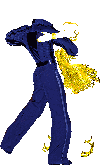 |
ROUND DANCING — CHOREOGRAPHED BALLROOMEDUCATIONAL ARTICLESMAJOR SECTIONS: Figures | Articles | Links | Alph. Index | Search | Home |
|
|
About Those Chasses …by Roy & Phyllis Stier We have been asked to discuss the Chasse in its different forms, and it turned out to be an interesting subject. First, the Chasse is, in its simplest form, a matter of one foot chasing the other. It is used in several dance rhythms, where it varies from a rudimentary sort of motion to a fairly good production number. The quickstep probably has a priority claim on this figure because it has incorporated the Chasse as a prime basic. The Progressive Chasse is a left foot lead for the man and is on the toes as he turns approximately 1/4 to the left (usually after backing toward diagonal center and ends facing diagonal wall with a Q,Q,S timing). Most of the turn is made between steps 1 & 2; however, the lady divides up her turn on steps from 1 to 3, also on the toes. If we took the Progressive Chasse to the right, it is the man who divides up the turn, taken usually starting facing diagonal center and ending backing toward diagonal wall. The rule is almost always universal that the person on the outside of a turn divides it up. The Tipple Chasse is just an adaptation where the couple normally sways in the direction of the Chasse and gives the impression of "tipping." A Chasse 4 is a step on each beat, again on the toes using the same basic motion as the 3-step version. A Cross Chasse is a 4-step figure (S, Q, Q, S) where there is no direction change but goes from closed position to contra banjo. In the above, a preparation step on the slow count precedes the Chasse. The Tipsy Chasse is only used in quickstep and is characterized by short, non-closing steps (Q & Q).We see the non-closing Chasse again in the swing or jive. This is Q & Q timing but is considered a flat variety because of the nature of the dance rhythm. If used in cha cha, the timing is Q, Q, S and uses the normal closing action. In the waltz, we split the 2nd beat in half and count it 1, 2&, 3. It is important to develop a hovering action on the 3rd step to prepare for a full count on step 4 (not really a part of the Chasse in its generic form). A stretch of the left side is used to prevent the leaning look but is really designed to give a better move from the supporting foot. The knees and ankles should close and a slow down of movement is used on the hovering action = a slow count. The Ripple Chasse used primarily in the waltz is a right sway in semi-closed position where the partners straighten up on the 4th step. The semi-closed position is used nearly exclusively in the waltz and fox trot for the 3-step Chasse and does not turn in either direction. Only recently do we see the use of the Chasse in fox trot where the timing is Q, Q, S (footwork: T, T, T/H). Some further notes: The original use of the Chasse is for either or both to turn to anticipate the next figure — usually it is the lady that turns. * It cannot go directly down line of dance, for instance, or it would not be a pure Chasse. When leading a Chasse from semi-closed position, the man must move the left side forward first, then slow down the speed so the lady can catch up. There really is no such animal as a Back Chasse, although we sometimes do something approaching it as we make a transition to go forward. We often hear a 2-step dance using closing steps cued as a Chasse, however, this is not proper due to the reasons given above. There's more but this will have to do for now. Keep tuned. *exception — SCP Chasse
This column comes from a series published in Cue Sheet Magazine between 1987 and 1992, and is reprinted with permission. The full series is collected in an 86-pg booklet, available for $30.00 plus postage. E-mail Fran Kropf at cutecuer@cox.net. This article was published in the Dixie Round Dance Council (DRDC) Newsletter, February 2009.
|
 |
|
|
Page last revised